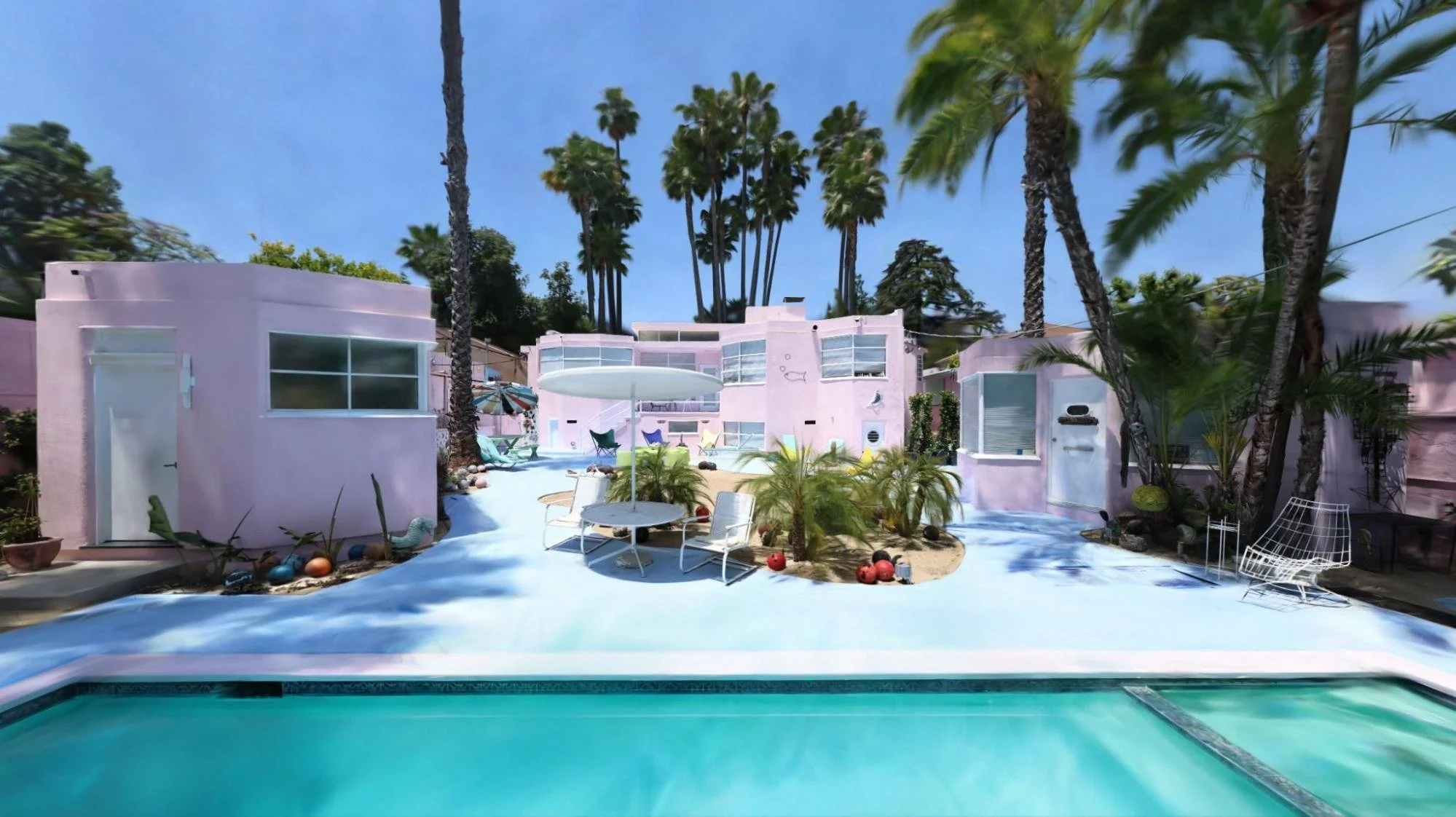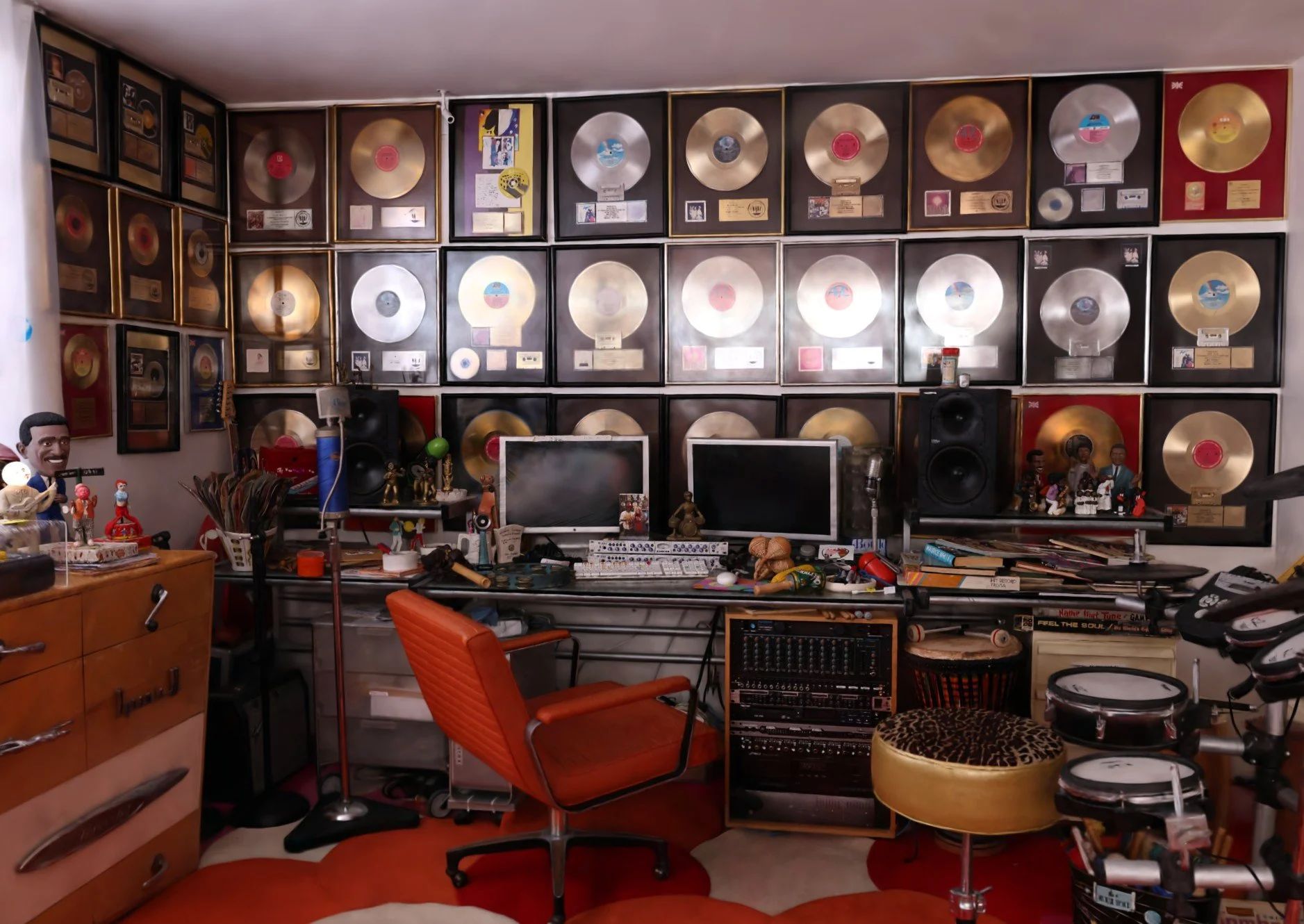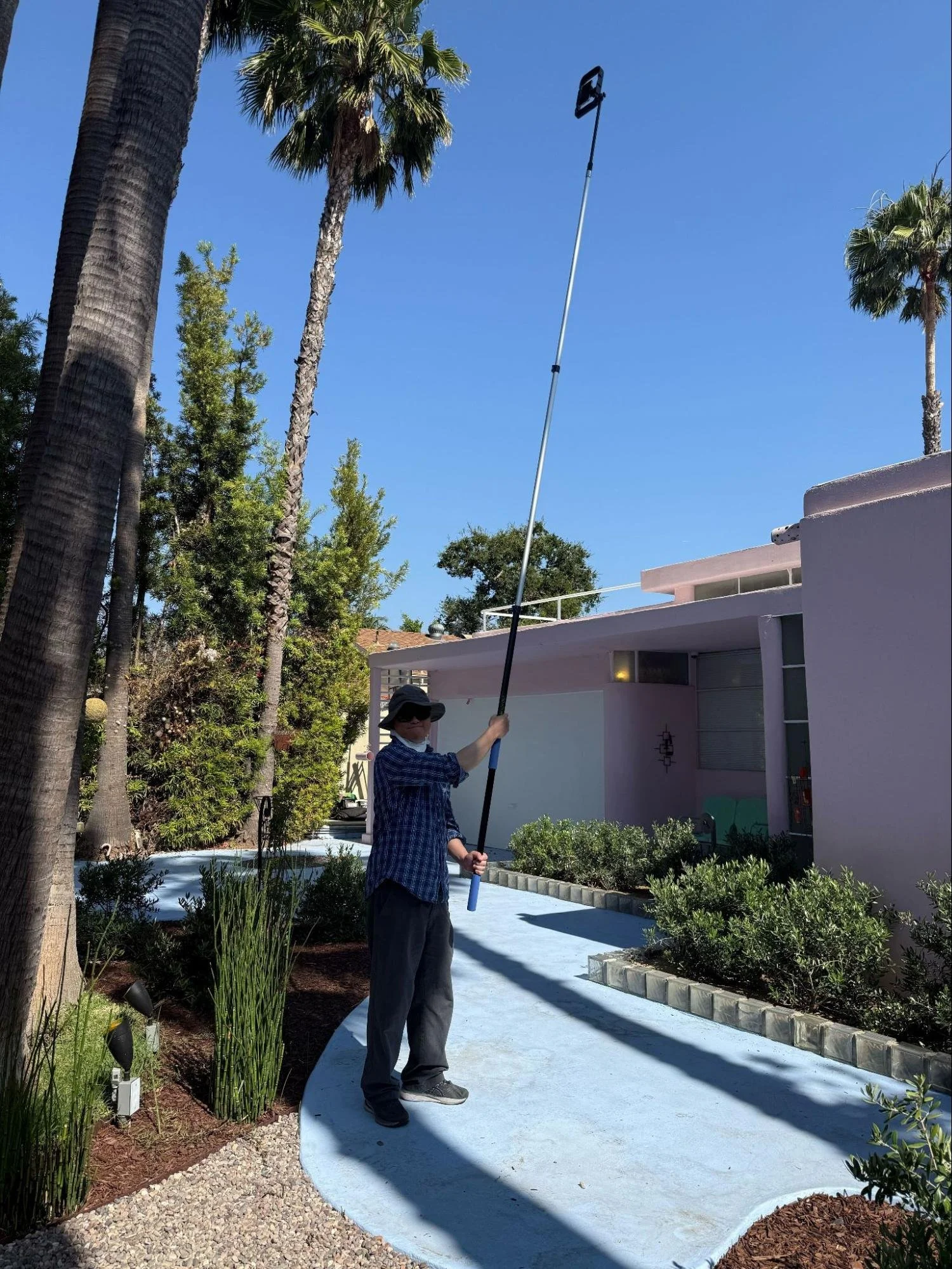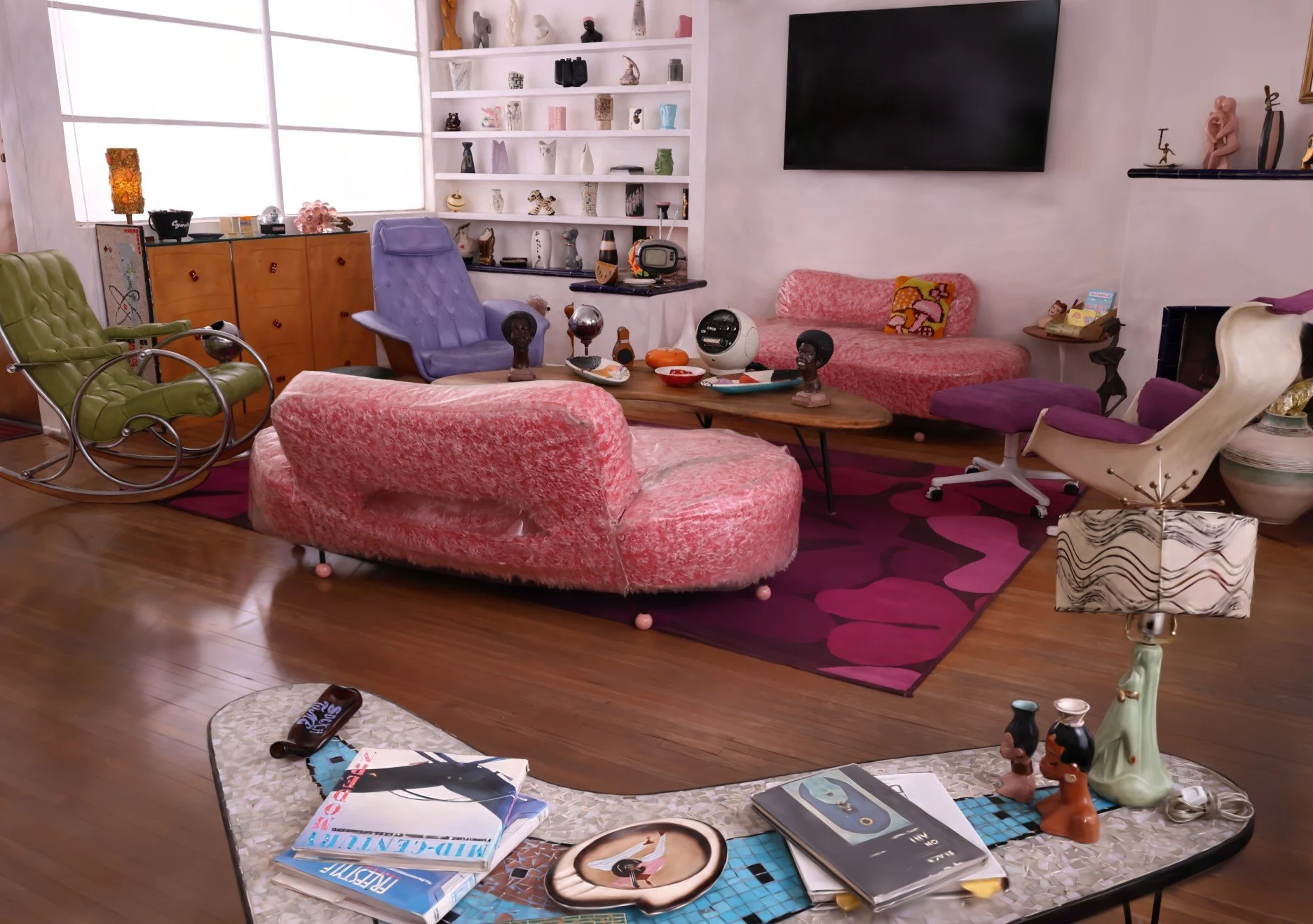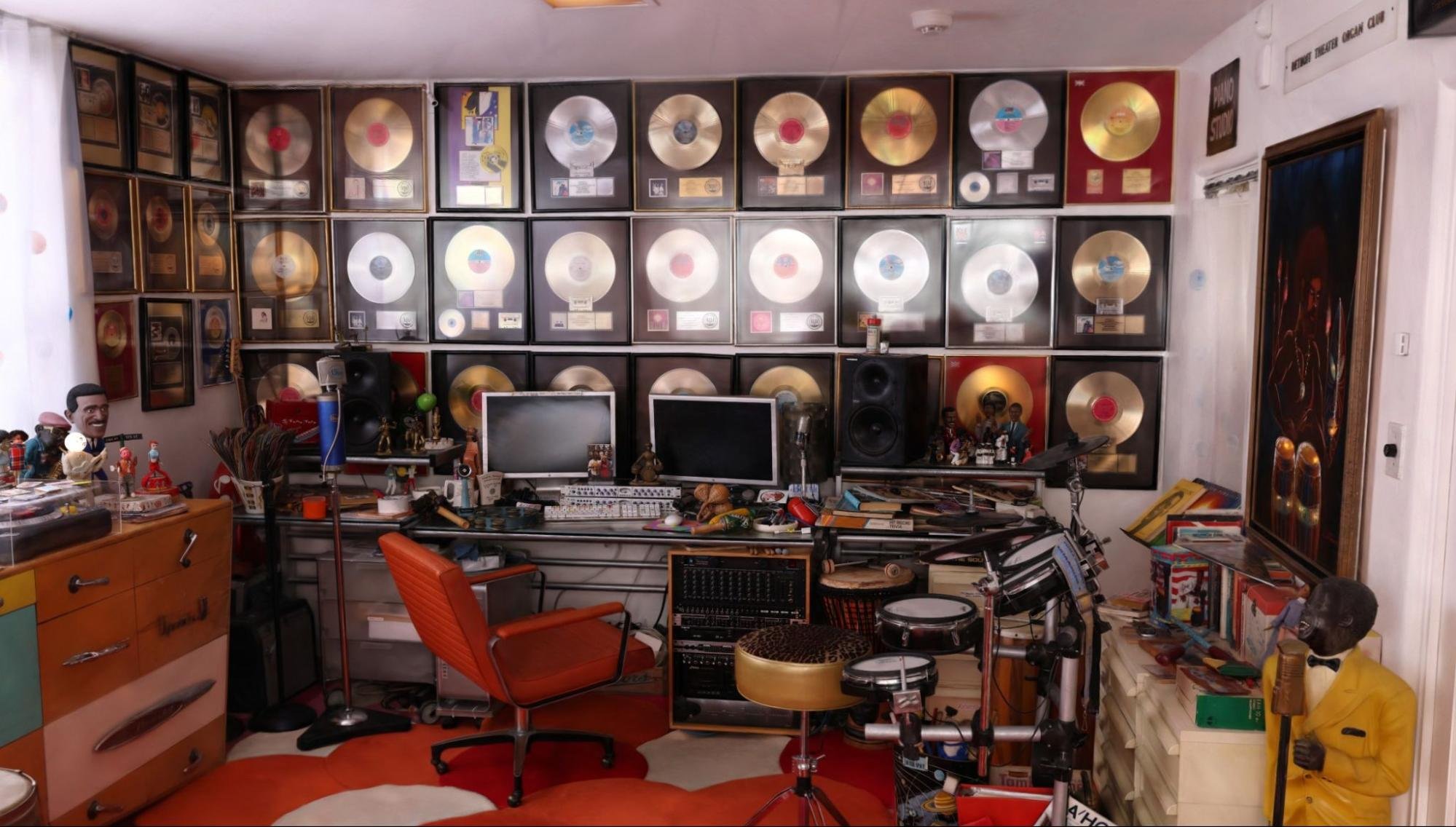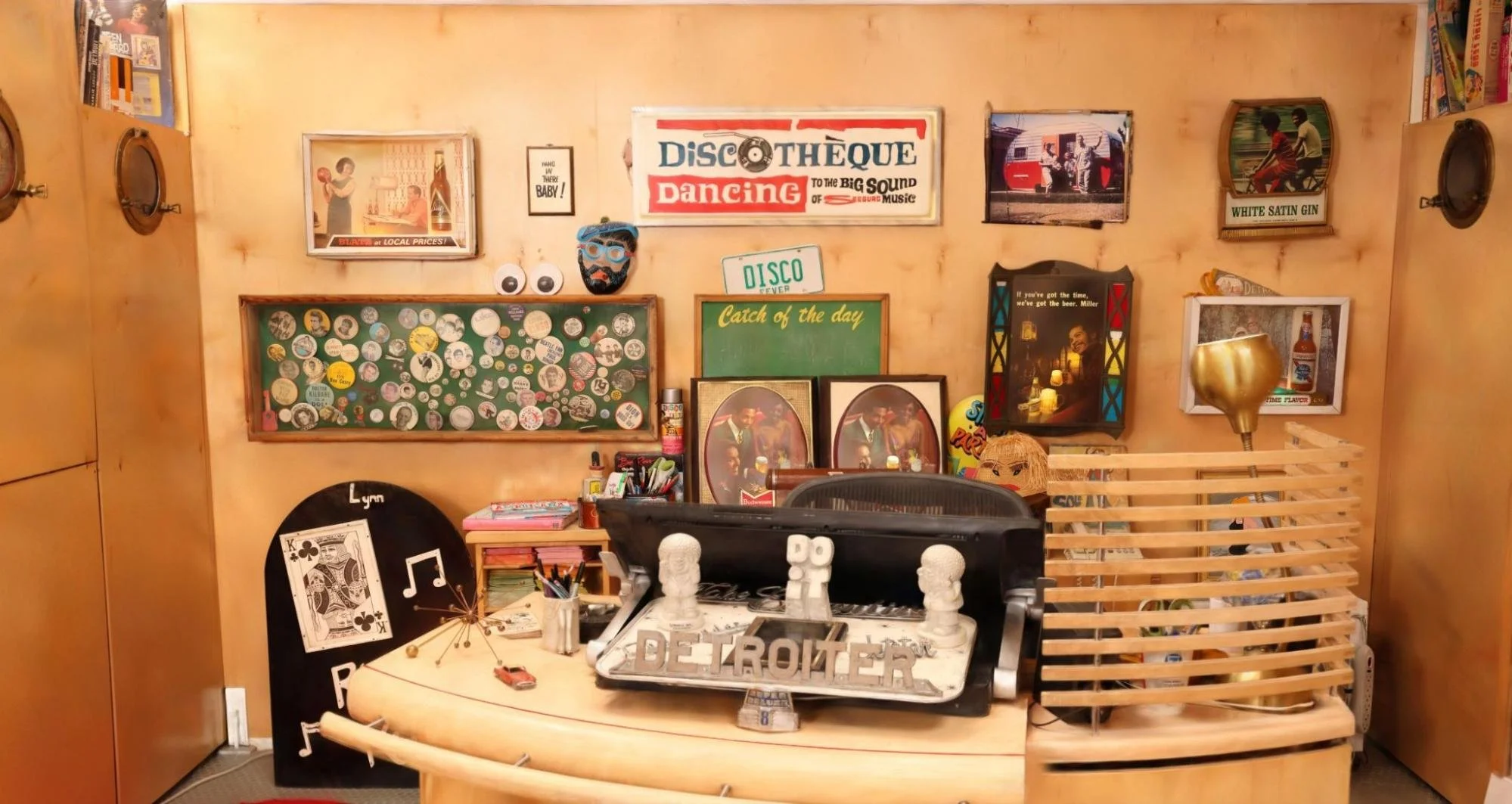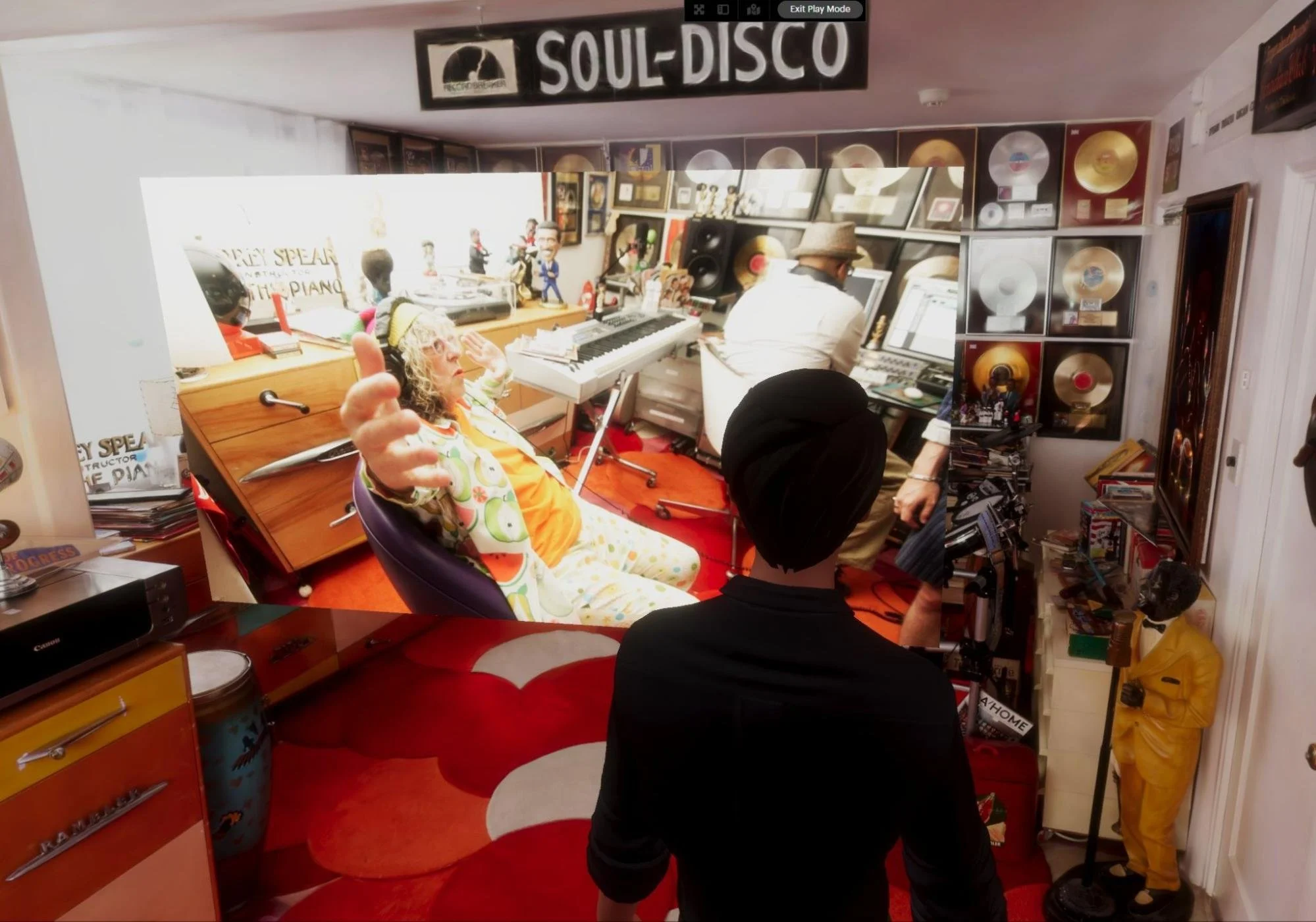Gaussian splats at work in the Allee Willis House: 10 key takeaways for 3D creators
A Gaussian splat of the Allee Willis house, also known as Willis Wonderland. The house is a 1937 Streamline Moderne home in North Hollywood, Los Angeles, that showcases the personal art and Kitsch collection of the songwriter.
Gaussian splatting is a relatively new technique for real-time radiance field rendering, and by creating more than 1200 Gaussian splats from hundreds of thousands of photos, we’ve learned a lot! Before diving into what we’ve learned, it’s worth looking at how Gaussian splats compare with other popular approaches to 3D capture and rendering: photogrammetry, LiDAR, and NeRFs. Each technology has its strengths and trade-offs, and in practice, we often use these techniques side-by-side. Here’s a handy comparison chart:
| undefined | What it does | Strengths | Limitations | How we use it |
|---|---|---|---|---|
| Gaussian splatting | Reconstructs 3D scenes from photos/videos using Gaussian point clouds. | Performs well with a wide range of surfaces including metallic, translucent, cloth, and glass surfaces. Handles fine and intricately complex structures very well. Real-time rendering. | Requires collision meshes from other techniques. The editing workflow is still evolving. Struggles with flat untextured surfaces and curved reflective surfaces. | Used as a core visual representation for complex digital twin scenes. |
| Photogrammetry | Creates polygonal meshes from photos/videos. | Works well on matte surfaces, and even better on matte textured surfaces. Produces familiar mesh geometry (easy to edit in Maya and Blender). Great for creating collision meshes. | Sensitive to surface material qualities. Struggles with shiny, metallic, translucent, reflective materials. Does not handle fine structures well. Often requires significant editing. | Used as collision meshes for Gaussian splat scenes. Also, when cleaned up, photogrammetry works well for digital twins on a wide range of devices. |
| LiDAR (Light Detection and Ranging) | Uses lasers to generate point clouds and polygonal meshes. | Excellent for scale reference. Professional LiDAR scanners are capable of achieving millimeter-level accuracy. | iPhone LiDAR suffers from drift & limited accuracy and range. Visual quality is often not as high fidelity. | Used for scale reference. |
| Neural Radiance Fields (NeRFs) | Represents a scene as a radiance field learned from images, rendered via volume rendering. | Potentially higher visual fidelity than Gaussian splats. | Computationally heavy, and much slower to render compared to Gaussian splats. | Used as a visual reference. |
Ten lessons
To illustrate the lessons we’ve learnt, we’ll look at a case study from the Allee Willis Foundation. The foundation perpetuates the legacy and extraordinary creative vision of Hall of Fame songwriter and artist Allee Willis by fostering innovative opportunities in music education.
We were invited to photograph the interior and exterior of the Allee Willis house, working with a team of photographers, lighters, and production staff to preserve it as a digital twin for future research and creative projects.
Yes, this is a Gaussian splat, not a photo!
There are plans to turn our Gaussian splats into a virtual research space dedicated to Allee Willis's legacy.
A note on our process
Our advice is based on our experience using DSLR, mirrorless, and sometimes phone cameras for creating Gaussian splats. While we recognize the value of creating Gaussian splats with LiDAR-enhanced cameras, VR (virtual reality) and XR (extended reality) headsets with multiple cameras and a depth sensor, and mobile AR (augmented reality) based software solutions, our focus in this guide is on achieving high-quality results with standard photography equipment. We also avoided using drones for our recent projects due to permitting complexities, though they can be useful for certain environments. For best results, we recommend using still photos over video to avoid motion blur and benefit from a higher image resolution.
The photography process
For each shoot, a simple, repeatable process is key:
Set up: Use a single prime lens and sensor for a room or object for the entire shoot.
Calibrate: Set your camera's shutter speed, aperture, ISO sensitivity, color temperature, and focus carefully, and turn off in-body image stabilisation (IBIS). Avoid a shallow depth of field by using a narrower aperture to make sure that everything is in focus. Adjust settings while shooting as necessary if you are in a situation where the lighting changes during the shoot (for example: dawn or dusk).
Shoot: Take a lot of photos, moving slowly and deliberately to ensure a high degree of overlap between shots. Do whatever it takes to avoid motion blur, even if it means using a monopod, a tripod, or a faster shutter speed.
Wherever possible, shoot in RAW format for greater flexibility, and use a polarized lens as needed to minimize unwanted reflections. Establishing a scale reference can be helpful. By following these guidelines, you'll be well-prepared to capture high-quality images for your Gaussian splat projects.
Let’s dive into what we’ve learned!
1. Beyond the circle: alternative camera trajectories for 3D modeling
When you're creating a 3D model from photos using techniques like Gaussian splats or photogrammetry, the path your camera takes – the trajectory – is just as important as the photos themselves. While it's often recommended to shoot full circles or a dome around your subject, this isn't always possible. Obstacles like walls or furniture can get in the way.
The 70% overlap rule
This is the golden rule of thumb: each photo should have at least 70% overlap with the previous one. Hitting 80% is even better. A high degree of overlap is crucial for the camera pose calculations, which figures out the position and orientation of your camera for each photo. Without enough overlap, this process can fail, resulting in an unusable reconstruction.
Circles and domes
The classic circles/dome trajectory, where the camera points towards the center of a circle/dome/cylinder, works well because it naturally ensures this high overlap. There should be several circle trajectories at various heights to form a dome or cylinder. (See this article for more information on circle trajectories.)
The power of concave half-shells
Based on our experience, we've found that you can still get excellent results by adapting your approach. The key principle is to maintain a high degree of overlap between your photos.
When a full circle/dome trajectory isn't an option, our most important discovery is that concave half-shell trajectories are a fantastic alternative.
Think of it this way: instead of a full circle, you're shooting an arc. With this method, you move your camera along a curved path while it continuously points towards a single focal point. This simple approach is a powerful substitute because it mimics the natural overlap of a circular path, making the camera pose calculations far more likely to succeed. Make sure to photograph each area using several arc trajectories at various elevations, just as you would for the circles/dome trajectory.
Concave half-shell camera trajectory diagram.
While we weren’t able to photograph in a circle trajectory around the recording equipment, desk, awards, and drum kit, we were able to use concave half-shells to successfully create a Gaussian splat of this area.
Trajectories to avoid
Just as some trajectories help, others can make your job much harder.
Linear trajectories, where you move in a straight line without changing your angle, can be risky. On their own, they often don't provide enough different vantage points for the camera pose calculations to work properly. If you use a linear trajectory, we recommend changing the angle of the trajectory from time to time to help the calculations succeed.
Convex trajectories, where your camera is pointing away from the center of an arc, are an even higher risk. This type of trajectory may be tempting if there are several objects to photograph around the periphery of a large room. However, it's trickier to get 70% to 80% overlap between subsequent photos when your camera is pointed away from the center of an arc, making a successful reconstruction much more difficult.
Key takeaway
When a circle/dome trajectory isn't possible, a well-planned concave half-shell trajectory is your best bet for capturing high-quality 3D models. It's an effective way to maintain the crucial 70%+ photo overlap needed for a successful reconstruction.
2: Mirror, mirror on the wall
Mirrors are tricky! Flat mirrors often look great with Gaussian splats, but reflections on curved surfaces are currently a major challenge.
Note that Gaussian splats handle flat mirrors quite well. You can see the headboard and framed artwork is successfully reflected in the mirror.
Gaussian splats of spaces with flat mirrors work well because the mirrors create a convincing "mirror universe," a duplicate version of the room on the other side. As long as there are no overlaps between scenes from multiple mirrors, the effect is very convincing.
The challenge of curved surfaces
In contrast, curved mirrors or highly reflective, curved surfaces do not work as well with Gaussian splats. The reason is that light is reflected at different angles from every point on the curved surface, which makes it very difficult to consistently reconstruct the "mirror universe." The Gaussian splat training process attempts to aggregate a reconstruction from these multiple angles, resulting in a distorted and messy virtual scene.
If you run into reflection artifacts on curved surfaces, you could attempt to use cross-polarized photography to reduce reflections. Alternatively, using higher-order spherical harmonics could help to enhance the visual appearance of reflections. However, even with higher-order spherical harmonics, accurately capturing complex reflections on a curved surface remains a significant hurdle. Mitigating reflection artifacts on curved surfaces is currently an active area of research.
Key takeaway
Flat mirrored surfaces work because the reflections are consistent. Curved reflective surfaces are a struggle because their inconsistent reflections create a distorted and messy reconstruction that current technology struggles to accurately resolve.
3: Comprehending the formless: why flat untextured surfaces are so tricky
Imagine you are in the middle of a uniformly lit white, untextured room without any discernible corners, furniture, objects, or shadows. How would you understand the shape of the room with just your eyes? Until you use your hands and feet (which are not completely unrelated to depth sensors), it’s difficult to comprehend the space. This is the same problem that computer vision algorithms face with uniformly lit, flat, untextured surfaces. The reconstruction process is essentially guessing the shape of a surface that it can't see clearly, leading to an imprecise result.
Using image-based analysis alone, the problem with a flat, untextured, uniform surface like a white wall is that it has few discernible feature points, which the software can use to correctly reconstruct the surface. Because the software has difficulty figuring out where the wall or ceiling is, these appear as blurry, undefined "clouds" in the final reconstruction. We saw this firsthand at the Allee Willis house and were able to confirm it in controlled tests with a large white poster board.
While Gaussian splats perform well on complex textured surfaces such as the collage of Allee Willis in the center of this Gaussian splat, you’ll notice that the adjacent walls are more cloudy. California artist Jason Mecier created this captivating collage entirely from household junk, toys, collectibles, and other objects that sparked his imagination.
As human beings, we can make semantic inferences, which help us to understand flat, uniformly lit, untextured surfaces like a wall or a ceiling. Some types of 3D reconstruction software are beginning to use semantic understanding of scenes to create cleaner models. We’re hoping that, in time, structure from motion and Gaussian splatting techniques could incorporate semantic understanding to help resolve flat, untextured walls and ceilings that currently appear cloudy or formless. (Although we’re not covering depth sensors in this article, LiDAR or structured light sensors, such as those on modern XR headsets, could be used to resolve the cloudy wall/ceiling issue as depth sensors have a special advantage in understanding where these flat, untextured surfaces are in space.)
There is no perfect fix, but here are some things you can do to manage this issue:
Add visual markers: In a controlled environment, adding markers (like black dots or tape) can help. These give the software the feature points it needs to correctly resolve the surface. These visual markers could be removed later when editing the Gaussian splat. However, adding markers isn't always a practical solution for real-world scenarios.
Vary your angles: Taking a large number of photos from a wide variety of angles can sometimes help. By capturing the surfaces from many different perspectives, you give the software more information to work with.
Editing is an option: Sometimes, the only solution is to edit the final Gaussian splat afterwards. This allows you to manually clean up the cloudy areas (or remove temporary visual markers).
Key takeaway
Flat, untextured surfaces are currently difficult to reconstruct accurately with Gaussian splats because they lack the necessary feature points for the software to anchor against. While adding markers or taking a large number of photos could help, you should be prepared to perform some post-processing edits to mitigate the "cloudy wall" effect.
4: Capturing a scene: the value and limitations of video
When capturing a space for a 3D model, taking individual photos with a high-resolution camera is often the gold standard. But what about video? Can you create a good model from video footage alone? We tested this by using 4K video from a camera on a four-meter selfie stick to capture the entire exterior of the Allee Willis house.
The entire exterior of the Allee Willis house, including the roof, was reconstructed as a Gaussian splat using frames from video, thanks to the help of a selfie stick! (Flat satellite imagery was used for the surrounding homes for context.)
Photo of a Gaussian splatter holding a selfie stick. Picture taken by Johanna Gardner.
The two critical factors: light and resolution
Our experiment showed that video can be a viable option, but success hinges on two key factors:
Light: The biggest concern with using video is motion blur. Since video is just a rapid series of images, any camera shake or fast movement can blur individual frames. This blur makes it very difficult for the software to find the unique feature points it needs for a successful reconstruction. In our test, there was plenty of natural light, which allowed for a faster shutter speed, effectively eliminating motion blur.
Resolution: Even with great lighting, video has inherent resolution limits. While 4K video resolution (3840x2160 pixels) offers a good level of detail, it typically can't compete with the resolution of a modern full-frame DSLR or mirrorless camera. As a result, a Gaussian splat created from video may not be as sharp or detailed as photos using a full-frame sensor. If video-based Gaussian splatting is an approach you’d like to pursue, we’ve seen examples where a rig of multiple video cameras could produce better results than one video camera alone.
Key takeaway
Despite the resolution limitations of 4K video, we were pleasantly surprised by the results of our test. When shot in a well-lit environment that minimizes motion blur, a 4K video can be an effective way to capture a scene. While the final Gaussian splat from a 4K video may not have the same level of detail as one created from high-resolution still photos using a full-frame sensor, it can still provide a good representation of a space.
5: Prioritizing your shots: the art of triage in complex scenes
The biggest challenge with Gaussian splatting is that any angles you miss while photographing an object will likely result in issues in your final 3D Gaussian splat. Photographing a single object is easy. But what happens in a complex environment?
The all-encompassing challenge
It's relatively easy to capture all the necessary angles for a single, isolated object using a comprehensive approach like the classic circles/dome trajectory or the concave half-shell trajectory. However, this becomes much more difficult when you're trying to photograph an entire room filled with hundreds of objects, like a museum exhibit or a crowded open office. In these complex environments, it's virtually impossible to get perfect coverage of every single object from every angle. This is when you must be strategic with your approach.
There were several hundred items of interest in the living room and dining room. We had to triage in order to determine which objects to photograph more carefully to create this Gaussian splat.
Alternate angle of the living room and dining room showing the vast number of items of interest.
Strategic triage
To handle this, you need to triage your photo capture. This means prioritizing your efforts to ensure you get the best possible coverage of the most important objects in the scene. Take a full range of photos of the primary subjects of interest. For secondary or background objects, it may be necessary to take fewer photos or use less comprehensive trajectories. By making these choices, you accept that some parts of the scene may not be perfectly reconstructed, but you guarantee that the most critical elements will be captured with sufficient detail and accuracy.
Key takeaway
The angles you don't photograph may come back to haunt you, as there will be missing information in those areas. However, in complex scenes with many objects, it may be difficult to capture every angle. Therefore, it's essential to strategically prioritize and triage your photo capture to ensure the most important objects are well-represented, even if it means sacrificing some detail on less critical elements.
6. Low light? No problem! Shooting at higher ISO
When working with Gaussian splats, using a higher ISO (a measure of light sensitivity as determined by the International Organization for Standardization) setting can be a viable option in low-light conditions, as there is still often enough information for the structure from motion (SfM) process to succeed. While higher ISOs introduce more noise, a careful approach can still yield successful 3D reconstructions. Of course, we don’t recommend resorting to a very high ISO until you’ve first made reasonable adjustments to shutter speed and aperture.
An earlier version of the recording studio was photographed at a much higher ISO (ISO 40,000 using a modern full-frame sensor) than the other rooms. The reconstruction was completely successful, even at a high ISO.
Structure from motion at higher ISOs?
One of the key techniques behind 3D reconstruction is structure from motion (SfM). This process works by identifying and tracking unique feature points in your photos. These could be anything from a unique mark on a floor to the corner of a window frame. The software identifies key points in each photo, matches them between different photos, and then uses those matches to mathematically reconstruct the 3D scene. This process is crucial for creating the point cloud data that Gaussian splats use to render a scene.
Higher ISOs, which increase a camera's sensitivity to light, introduce more digital noise, which may affect the accuracy of the SfM calculations. However, based on our experiments, this noise does not necessarily prevent the SfM algorithm from finding enough information to create a workable 3D reconstruction. The key is to take the photos carefully, minimizing motion blur and other potential issues.
Additionally, you may wish to consider using a tripod to afford slower shutter speeds when there is extremely low light. This will increase the amount of time for photography substantially, but the higher quality results could be worth the extra effort.
Key takeaway
While lower ISOs are always preferred for a cleaner capture, structure from motion can still successfully generate a 3D reconstruction from carefully taken, high-ISO photographs, making it a viable option for creating Gaussian splats in low-light environments.
7. Speed vs. quality: the case for JPG
When capturing a scene, the quality of the photos is paramount, but sometimes you don't have the luxury of time.
In high-pressure situations, such as a busy soundstage with tight deadlines, a team may have a very limited window to capture multiple setups. In these cases, it can be beneficial to sacrifice capturing photos in RAW format and instead shoot in a high-resolution JPG. While RAW files offer greater flexibility for post-production editing, because of the larger file size due to increased dynamic range and image quality, they take longer to write to the SD card, which can slow down a shoot considerably. By opting for JPG, you can significantly increase the speed at which you take photos.
The initial Gaussian splat test photo shoot of the art studio was done very quickly due to time constraints, and we didn’t have time to shoot RAW. But it turned out that JPG was more than sufficient for a successful reconstruction of the room.
The main risk of this approach is the lack of flexibility in post-production. Unlike a RAW file, a JPEG applies in-camera processing such as exposure, white balance, and saturation and then compresses the image. This makes it harder to correct mistakes later. Therefore, if you choose to shoot in JPG, it's crucial to ensure your exposure is set correctly. This will help you achieve the best possible result despite the time constraints.
Key takeaway
In time-critical situations, shooting high-resolution JPG photos can save you valuable time over RAW, allowing for a faster photo shoot. The trade-off is that you must ensure your camera's exposure is perfect, as you will have very little latitude to adjust the image later.
8. The 5000 Photo Challenge: when more isn’t better
When it comes to creating a Gaussian splat, there's a practical limit to the number of photos you can use. As the photo count increases, so does the time required for the structure from motion (SfM) calculations. Beyond 5000 photos, there is a real risk that your computer may run out of memory, even if you have the time to wait for the structure from motion computations.
In one attempt to compute structure from motion on the photos of the exterior of the home, we tried to use too many photos, and the computer ran out of memory. We had to use less photos for the computation to succeed.
The 5000 Photo Threshold
Based on our practical experience, SfM computations become significantly slower after about 5000 photos. For this reason, it's often more efficient to use a targeted number of photos for your reconstruction, depending on the visual fidelity requirements.
Here are some general guidelines for photo count based on desired visual fidelity:
Very high fidelity: 3000 to 5000 photos
High fidelity: 1000 to 2000 photos
Medium fidelity: 500 to 900 photos
Lower fidelity: 100 to 400 photos
Very low fidelity: 20 to 50 photos
The training process
The total time it takes to train a Gaussian splat is a direct function of the number of photos. More photos mean more data for the algorithm to process, which increases the training time. The resolution of the photos is also a factor, and downscaling the photos will help speed up the camera pose calculations. Smaller reconstructions may take a few hours, and complex scenes can take many hours, or even several days. A key factor to increasing the probability of success is ensuring a very high degree of overlap between your photos. Without sufficient overlap, the SfM algorithm won't be able to accurately align the images, leading to a failed reconstruction.
Key takeaway
For efficient and reliable Gaussian splat reconstructions, it's best to work with a targeted photo count rather than using as many as possible. Exceeding 5000 photos significantly increases processing time for the structure from motion calculations.
9. Ask permission!
While capturing photos for a Gaussian splat, your unusual movement pattern can draw attention. To avoid any potential misunderstandings or legal issues regarding copyright, ask for permission from the property owner, manager, or security personnel before you start. When you capture photos of a location or a specific object, you are also capturing the intellectual property of its owner. This could include copyrighted artwork, product designs, or even the unique architectural layout of a building. Without explicit permission, you could be infringing on their rights.
A simple and clear explanation of your project can often be enough to get the go-ahead, saving you from a potential misunderstanding down the line.
Key takeaway
Always try to get permission before shooting. Capturing photos for a Gaussian splat requires a distinctive movement pattern that can draw attention, so being prepared to explain your process can save you from interruptions and potential issues.
10. A note on editing
Editing Gaussian splats can be easy or difficult, depending on what you need to accomplish. Simple edits are quick and efficient, but precise and complex workflows remain challenging.
SuperSplat
SuperSplat is an indispensable tool for viewing and editing splats. It makes basic workflows easy, allowing you to select, edit, delete, move, rotate, and scale splats. For example, you can select a spherical region of interest and quickly delete everything outside of it, or combine separate splats into one file. SuperSplat can even edit the color of splats and works on both a desktop and an iPad.
While SuperSplat is excellent for simple edits, more complex workflows requiring precision are challenging. For a large project like the Allee Willis house, which involved many tens of thousands of photos, it was impossible to process everything at once. We had to break the home into sections, but we found that putting them all back together to form a cohesive, seamless Gaussian splat was a major hurdle. This is because precision workflows with Gaussian splats are currently not as straightforward as similar operations on polygonal meshes in software like Maya or Blender.
The challenge of precision
While basic edits are straightforward, achieving high-precision edits is much more difficult. This is because Gaussian splats are inherently more complex to edit than polygonal meshes. Splat "brush strokes" are interwoven, meaning one change can lead to a cascade of problems. Fixing a splat can feel like mending a frayed straw weave hat – pulling on one long splat to fix a visual artifact can cause a chain reaction that disassembles other parts of the scene. However, the field is advancing rapidly, and new research is being published frequently. In the future, editing Gaussian splats will undoubtedly become much easier and more intuitive.
Additionally, current Gaussian splat editing software struggles to sort the depth of separate splat objects in the same scene. This means that a Gaussian splat object that is partly or mostly behind another splat object may be rendered partly or mostly in front of that other object. Consequently, it becomes more challenging to understand the placement of Gaussian splats relative to each other in space.
This difficulty becomes most apparent in high-precision workflows, such as:
Aligning splats that are co-located precisely against each other.
Merging splats with critical boundaries seamlessly.
Fixing visual artifacts like "cloudy walls."
Key takeaway
Simple edits are easy and efficient, but precise and complex workflows remain challenging due to the interwoven nature of the splats. While current Gaussian splat editing tools are easy to use for basic tasks, precision editing requires significant time and manual effort.
Bonus tip 1: Gaussian splat software recommendations
The following is a partial list of software/services that can be used to process photos or video to create (train) Gaussian splats:
NeRF Studio is a solid NeRF and Gaussian splat solver, but it will take time to compile and set up. A secure option, as it runs locally on your computer.
Postshot provides visual feedback while the Gaussian splat is being trained, and it runs locally on your computer.
Polycam’s Gaussian splat cloud solver will take up to 1000 photos (up to 2000 for photogrammetry).
RealityScan doesn’t train Gaussian splats, but it is very reliable for structure from motion calculations for cameras for Gaussian splats, as well as for photogrammetry.
As always, be sure to read the terms and conditions to make sure it’s a good fit for the needs of your project or organization.
Bonus tip 2: turning a Gaussian splat into a digital twin with OKO
OKO is our game-changing platform that can use Gaussian splats as a foundation for the creation of a digital twin. It allows teams to enter spaces and collaborate in real-time, on desktop, mobile, and XR web browsers, iOS, and even Unreal Engine. We’ve used OKO for collaboratively planning complex projects in real-time, and Gaussian splats are integral to our workflow.
OKO workflow for digital twins using Gaussian splats
Phase 1: capturing the space
The journey begins by capturing a physical space using a camera. These photos are processed to create a Gaussian splat. We also recommend creating a photogrammetry mesh from the photos for the next phase.
Phase 2: building the digital twin
The Gaussian splat is used as a foundation to create a 3D digital twin. Photogrammetry can be used as a collision mesh that is aligned with the Gaussian splat, as splats do not inherently support collision. Photogrammetry as a collision mesh works remarkably well for stairs, inclines, walls, bridges, and passageways.
Visiting the recording studio in OKO.
Phase 3: bringing the space to life
Once the digital twin is built, teams can add other objects and interactions to bring it to life.
The recording studio in OKO with a video interaction.
Key takeaway
OKO turns a scan of a real-world location into a shared, collaborative digital space where people can meet and work together from anywhere. It's a powerful way to democratize digital twin creation, and there’s nothing quite like experiencing a new space with friends, colleagues, clients, and collaborators.
Final thoughts
Gaussian splats represent a major leap forward, offering stunning aesthetic quality that traditional photogrammetry and LiDAR simply can't match. While we are more familiar with working polygons, in our experience, the challenges of editing Gaussian splats are worth the effort.
The visual benefits are compelling enough that we’re not waiting for the "next big thing." We're all in on Gaussian splats. With a rapidly growing ecosystem and a passionate research community, we're confident that improved tools and techniques will soon make the editing process much more efficient. And we're excited to be part of the community, pushing the boundaries of what's possible.
Credits
Creating these Gaussian splats would not have been possible without Vince Beggs and Prudence Fenton from the Willis Wonderland Foundation inviting us to create a Gaussian splat digital twin of the Allee Willis house.
Rusty Blazenhoff, Sean Welch, and Ari Bird, also from the Willis Wonderland Foundation, helped us in numerous ways during the photo shoot, shared countless stories about Allee Willis, and taught us so much about the history of Allee’s house.
While Fabian Flores’ Gaussian splats are not shown here, Fabian did an amazing job of Gaussian splatting other parts of the Allee Willis house. Fabian also worked with Julio Salcedo to digitally scan and measure the entire house for scale reference.
Julio Salcedo, Troy Chu, Hanuel Kim, Teruhisa Yoshida, and Darren Bunch did an excellent job of lighting the house for the interior shots.
Shriya Wani helped to add scripted interactions in OKO.
Alessio Regalbuto, Sam Birley, and Adrian Meredith did a superb job of enabling OKO iOS, Unreal, and Web to render Gaussian splats for collaborative visualisation.
Ashley Bravo, Johanna Gardner, and Keith Michaelis are wonderful producers who helped make sure everything ran smoothly.
And last, but not least, Lap Luu, Kevin Mullican, Daisy Leak, Alicia Mirelez, and Daksh Sahni supported this Gaussian splat project from leadership roles at Magnopus.

